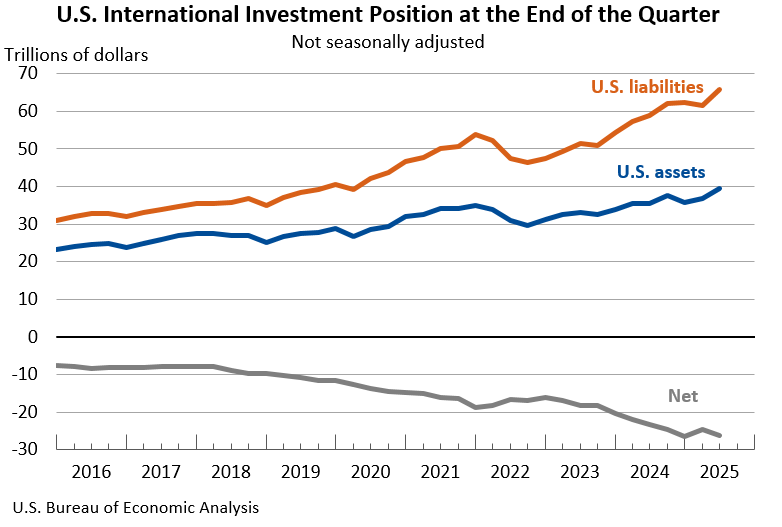Bureau of Economic Analysis
U.S. International Investment Position, 2nd Quarter 2025
The U.S. net international investment position, the difference between U.S. residents’ foreign financial assets and liabilities, was -$26.14 trillion at the end of the second quarter of 2025, according to statistics released today by the U.S. Bureau of Economic Analysis. Assets totaled $39.56 trillion, and liabilities were $65.71 trillion. At the end of the first quarter, the net investment position was -$24.65 trillion (revised).
Principal Federal Economic Indicators
Noteworthy
The Latest
Gross Domestic Product, Fourth Quarter and Year 2022 (Second Estimate)
Real gross domestic product (GDP) increased at an annual rate of 2.7 percent in the fourth quarter of 2022, after increasing 3.2 percent in the third quarter. The increase in the fourth quarter primarily reflected increases in inventory investment and consumer spending that were partly offset by a decrease in housing investment.
Coming Soon: A Closer Look at the Mix of Global and Domestic Content in U.S. Exports
BEA is expanding its prototype statistics that provide a more complete and nuanced understanding of U.S. exports. Watch for an update and expansion of the statistics known as trade in value added, or TiVA, coming in March.
New Platform Helps Researchers Apply to Use BEA Microdata
Researchers interested in using BEA’s confidential microdata now have new resources for discovering the data and applying for access for their research projects.
The Bureau of Economic Analysis and other federal statistical agencies worked together to create a standard application process for the agencies’ restricted-use data, including BEA’s confidential, company-specific international trade and investment data.
New Health Care Statistics for First Year of COVID-19 Pandemic
The Bureau of Economic Analysis today released estimates for 2020 that measure health care spending by medical condition. In the first year of the COVID-19 pandemic, spending on infectious and parasitic diseases amounted to more than $222 billion, growing $83.3 billion over 2019, according to the statistics in BEA’s Health Care Satellite Account.
2022 Trade Gap is $948.1 Billion
The U.S. international trade deficit increased in 2022 according to the U.S. Bureau of Economic Analysis and the U.S. Census Bureau. The deficit increased from $845.0 billion in 2021 to $948.1 billion in 2022, as imports increased more than exports. The goods deficit increased $101.5 billion in 2022 to $1,191.8 billion. The services surplus decreased $1.6 billion in 2022 to $243.7 billion. The goods and services deficit was 3.7 percent of…
December 2022 Trade Gap is $67.4 Billion
The U.S. monthly international trade deficit increased in December 2022 according to the U.S. Bureau of Economic Analysis and the U.S. Census Bureau. The deficit increased from $61.0 billion in November (revised) to $67.4 billion in December, as imports increased and exports decreased. The goods deficit increased $7.4 billion in December to $90.6 billion. The services surplus increased $1.0 billion in December to $23.2 billion.
U.S. International Trade in Goods and Services, December and Annual 2022
The U.S. monthly international trade deficit increased in December 2022 according to the U.S. Bureau of Economic Analysis and the U.S. Census Bureau. The deficit increased from $61.0 billion in November (revised) to $67.4 billion in December, as imports increased and exports decreased. The goods deficit increased $7.4 billion in December to $90.6 billion. The services surplus increased $1.0 billion in December to $23.2 billion.
Gross Domestic Product for the Commonwealth of the Northern Mariana Islands, 2020
Real gross domestic product (GDP) for the Commonwealth of the Northern Mariana Islands (CNMI) decreased 29.7 percent in 2020 after decreasing 11.3 percent in 2019. The decrease in real GDP reflected decreases in exports of goods and services, private fixed investment, personal consumption expenditures, and government spending. Imports, a subtraction item in the calculation of GDP, also decreased.
Gross Domestic Product for the Commonwealth of the Northern Mariana Islands, 2020
Real gross domestic product (GDP) for the Commonwealth of the Northern Mariana Islands decreased 29.7 percent in 2020, after decreasing 11.3 percent in 2019, according to statistics released today by the U.S. Bureau of Economic Analysis.
The decrease in real GDP reflected decreases in exports of goods and services, private fixed investment, personal consumption expenditures, and government spending. Imports, a subtraction item in the…
Personal Income and Outlays, December 2022
Personal income increased $49.5 billion, or 0.2 percent at a monthly rate, while consumer spending decreased $41.6 billion, or 0.2 percent, in December. The increase in personal income primarily reflected increases in compensation and proprietors’ income. The personal saving rate (that is, personal saving as a percentage of disposable personal income) was 3.4 percent in December, compared with 2.9 percent in November.




